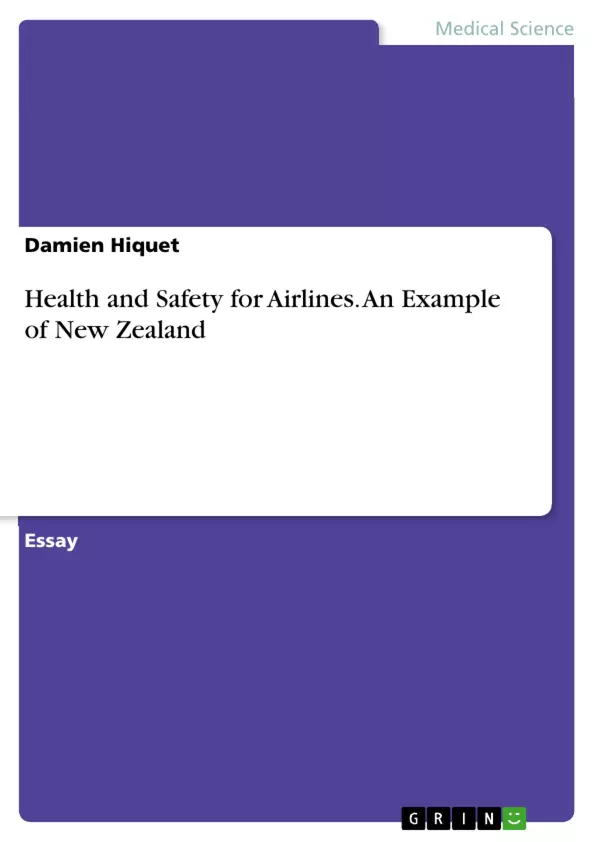This paper deals with Airline Occupational Health and Safety Management practice.
An airline is a complex organization with multiple management systems, dispersed operations, many technical functions, highly regulated- overlapping State jurisdiction, and subject to multiple national regulations.
Therefore, senior officers such as the Chief Executive Officer (CEO) and board directors must exercise due diligence on health and safety by having a good understanding of the risk profile of its operations, the key controls in place, and a system of providing information on whether these controls are working. In addition, leaders need to demonstrate to their staff, their suppliers, customers, and contractors that they mean it.
Inhaltsverzeichnis (Table of Contents)
- Introduction
- Organisational Governance and Operations
- The need to improve
- The Benefits
- HSWA 2015 Organisation Roles and Responsibilities
- Key terms
- Duties of PCBU
- Duties of officers, workers, and other persons
- Engagement and participation
- Health and Safety Management Systems (HSMS)
- Policy and planning
- Delivery
- Monitoring
- Review
- Conclusion
Zielsetzung und Themenschwerpunkte (Objectives and Key Themes)
This document explores the crucial role of leadership in promoting occupational health and safety (OHS) within the airline industry in New Zealand. It examines the complexities of airline operations, highlighting the need for robust management systems, effective communication, and a strong commitment to safety from all levels of the organization.
- The importance of leadership and good governance in fostering a positive OHS culture within airlines.
- The significant benefits of a strong OHS culture, including improved employee engagement, reduced workplace injuries and fatalities, and enhanced reputation.
- The legal framework surrounding OHS in New Zealand, specifically the Health and Safety at Work Act 2015 (HSWA) and the roles and responsibilities of various stakeholders.
- The implementation and management of effective Health and Safety Management Systems (HSMS) in the airline context.
- The challenges and opportunities associated with achieving and sustaining a positive OHS culture in the airline industry.
Zusammenfassung der Kapitel (Chapter Summaries)
- Introduction: This chapter provides an overview of the airline industry in New Zealand, highlighting the complexity of its operations and the need for strong leadership in OHS. It introduces the concept of "due diligence" and emphasizes the importance of effective communication and engagement.
- Organisational Governance and Operations: This chapter discusses the importance of a robust OHS culture that begins at the board level and extends throughout the organization. It explores the benefits of such a culture, including enhanced reputation, increased employee engagement, and improved productivity. The chapter also outlines the economic costs associated with workplace injuries and fatalities.
- HSWA 2015 Organisation Roles and Responsibilities: This chapter delves into the legal framework surrounding OHS in New Zealand, specifically the Health and Safety at Work Act 2015 (HSWA). It defines key terms, outlines the duties of various stakeholders, and emphasizes the importance of worker engagement and participation in OHS initiatives.
- Health and Safety Management Systems (HSMS): This chapter focuses on the implementation and management of effective HSMS within airlines. It outlines the key stages of an HSMS, including policy and planning, delivery, monitoring, and review. The chapter stresses the importance of a comprehensive and integrated approach to OHS management.
Schlüsselwörter (Keywords)
Key terms and concepts explored in this document include: airline safety, occupational health and safety (OHS), leadership, organizational governance, Health and Safety at Work Act 2015 (HSWA), Person Conducting a Business or Undertaking (PCBU), health and safety management systems (HSMS), due diligence, risk assessment, employee engagement, and workplace culture.
- Arbeit zitieren
- Damien Hiquet (Autor:in), 2021, Health and Safety for Airlines. An Example of New Zealand, München, GRIN Verlag, https://www.grin.com/document/1151088



